Parents Just Say No to SOLs
By John E. Bonfadini, Ed.D., Contributing Columnist;
Professor, George Mason University
Each semester my educational research class, composed of graduate students,
conducts studies on important educational issues as part of their course requirements.
This semester the student project centered on parental views of the Standards of Learning
(SOL). An optical scan survey instrument was designed containing 19 questions. The results
of the most pertinent questions in the survey are discussed here. A population sample of
373 parents completed the survey. The responses from Northern Virginia parents provided
both quantitative and qualitative data, which were statistically analyzed by the class.
The following is an abstract report of the findings. Question 1: The SOL (Standards of Learning) tests are an accurate measure of my child’s achievement.

Graph: Question 1
|
Graph number one shows parents’ responses to question one. The majority of parents
(59.4%) responded negatively to this statement. Slightly over 22% had not formulated an
opinion, while 17.7% supported the view that the SOLs are an accurate measure of their
child’s achievement. Only 1% strongly agreed with this statement. The graph also illustrates that females and males negatively
responded to this question with female responses being significantly more negative than
males. Data from other demographic factors not illustrated on the graph showed that
Caucasians and non-Caucasians also negatively responded to this question, but Caucasian
responses were significantly more negative. Those parents with a college education were
significantly more negative than non-degreed parents when responding to question 1.
Question 2: The SOL tests measure the most important information that every student should know.

Graph: Question 2
|
Fifty-seven percent of the parents disagreed or disagreed strongly with statement
number 2. Only 2% strongly agreed that the SOLs measure the most important information.
The correlation coefficient between questions 1 and 2 is high (r =.76), indicating a
strong relationship between the way parents answered these questions. Similar differences
shown in question 1 also exist for the demographic factors of gender, race, and education. Question 3: Teachers spend too much time teaching to the
test rather than teaching other important materials and topics.

Graph: Question 3
|
The following graph shows the total response to this question. Over 64% of the parents
agreed that teachers spend too much time preparing students for the SOLs. Approximately
13% showed some disagreement with this statement. Twenty-two percent responded with no
opinion to this question 3. Question 4: Failure to pass the SOL test should prevent a
student from receiving a high school diploma regardless of other evaluation factors such
as grades.

Graph: Question 4
|
Parents disagreed strongly with this statement. Only one in ten supported the concept that
passing the SOL tests should be the sole requirement for graduation. Seventy-seven percent
answered negatively to question 4. The "no opinion" category dropped to 11.6%,
indicating that parents have a more definite negative view about the proposed use of test
outcomes. Question 5: Teachers’ pay should be tied to their
students’ success on the SOL tests. Question 6: Students’ results on the SOLs
are a good measure of teacher effectiveness.
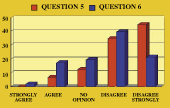
Graph: Questions 5 & 6
|
Parents do not support the concept that teachers’ pay should be associated with the
SOL tests. Over 80% disagree with statement number 5 as indicated by the red bar. Similar
results occurred for question 6. The negative response rate for this question was 61% as
shown by the blue bar. Question 7: The SOL tests add too much student anxiety for
the academic benefit gained.
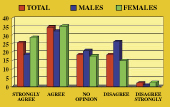
Graph: Question 7
|
Parents agreed with this statement — the academic gains that might be obtained
through the SOL testing program are not worth the increased level of student anxiety.
Female respondents were more concerned about the anxiety issue than males, although both
tended to agree with the statement. Question 8: I believe the current high test- failure rate
is an indicator of the SOL tests and not my child’s school.
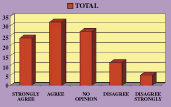
Graph: Question 8
|
Parents supported the hypothesis that the high SOL failure rate is a result of test design
rather than a poor educational environment at their child’s school. The percentage
ranges are similar to responses on other questions, which maintained a consistent pattern
through the survey.
Question 9: I have enough time and knowledge to help
prepare my child for the SOL tests. Question 10: I would be willing to pay for extra
tutoring or taxes for my child to pass the SOL tests.
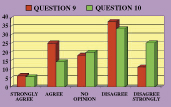
Graph: Questions 9 & 10
|
Only about one third of the parents responded positively to question 10, that they have
enough knowledge and time to assist their child with the SOL tests (red bars). The study
population had a high degree of parents with college educations (70%), creating additional
concern for children in less affluent areas of the state. Parents are not willing to
provide additional financial support so that their children can pass the SOL tests (green
bars). The study also found that no significant difference existed
between various parent groups with different household incomes and their willingness to
pay more taxes or tuition to obtain higher SOL passing rates. Even families with incomes
over $100,000 responded negatively to this question. Females were more negative than males
when responding to the financial-support question. Non-white respondents were more
supportive of increased financial support to areas with high failure rates. Question 11: The SOLs are more politically than
educationally motivated.
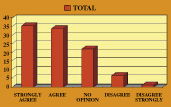
Graph: Question 11
|
The parents’ responses to this question may give some credence as to why they fail to
support the SOL testing program. Seventy percent think it is more a political process than
a sound educational strategy. Question 12: The SOL tests are not needed and the testing
program should be eliminated.
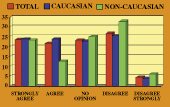
Graph: Question 12
|
The responses to this question were more equally distributed, although they still fail to
support the present testing program. The non-Caucasian population follows a similar
pattern to the Caucasian pattern but is significantly more supportive of the testing
program.
Conclusions:
The study lacked some of the
necessary random sampling techniques needed to accurately project the
findings to the entire state population, but it does provide some
significant findings about the perception parents have of the SOL tests.
Throughout the entire quantitative and qualitative data is a strong negative
response that the tests are flawed and used improperly as an educational
strategy. Parents believe the tests are more politically motivated than a
sound educational strategy. The higher the educational level of the parent,
the more negative they are toward the SOLs. These parents also believe that
the test will stymie creativity and fail to measure many important factors
in the educational environment.
|
What�s Your View?
Obviously, there are at least two
sides to every issue. Do you have a different view? This column is
meant to provoke thought, so keep sending comments. Each one is
read with the utmost interest. Send e-mail to: [email protected],
or send written responses to the editor or to John Bonfadini,
7500 Forrester Lane, Manassas, VA 20109. |
The parent population of this study does not support the
current punitive use of test results. They further believe that parents
should be given copies of the tests and their children should be allowed
numerous tries to pass the tests. The study results showed that parents
don�t believe the tests will lead to a significant improvement in the
quality of education for their children. There is a strong feeling that the
present testing program should be eliminated or modified and that results
should not be used as the sole criteria for high school graduation.
In my opinion, parents have taken a more realistic and
common-sense approach to the use of standardized tests than state school
officials. It�s time to implement the recommendations of the George Mason
University Graduate School of Education (January Issue) position paper.
Following the current path to improving education is a course that is flawed
and one which lacks necessary public support. More on the issue at a later
date.
|